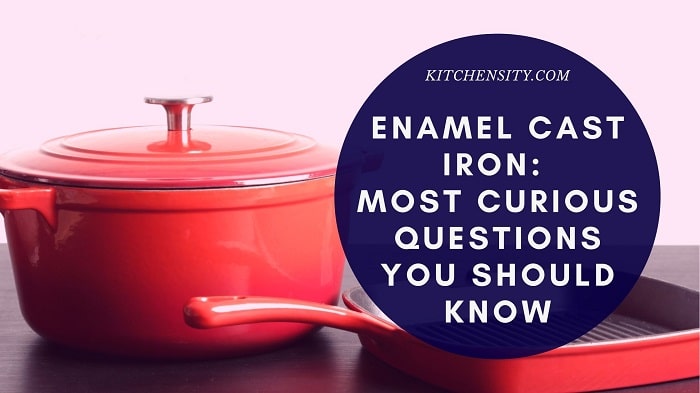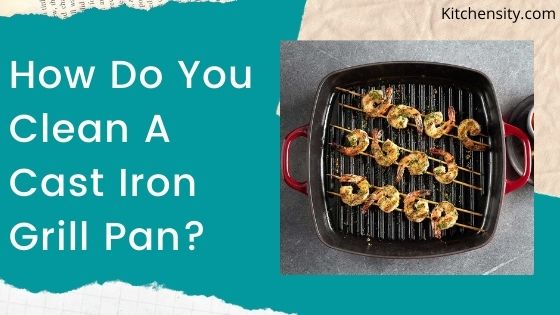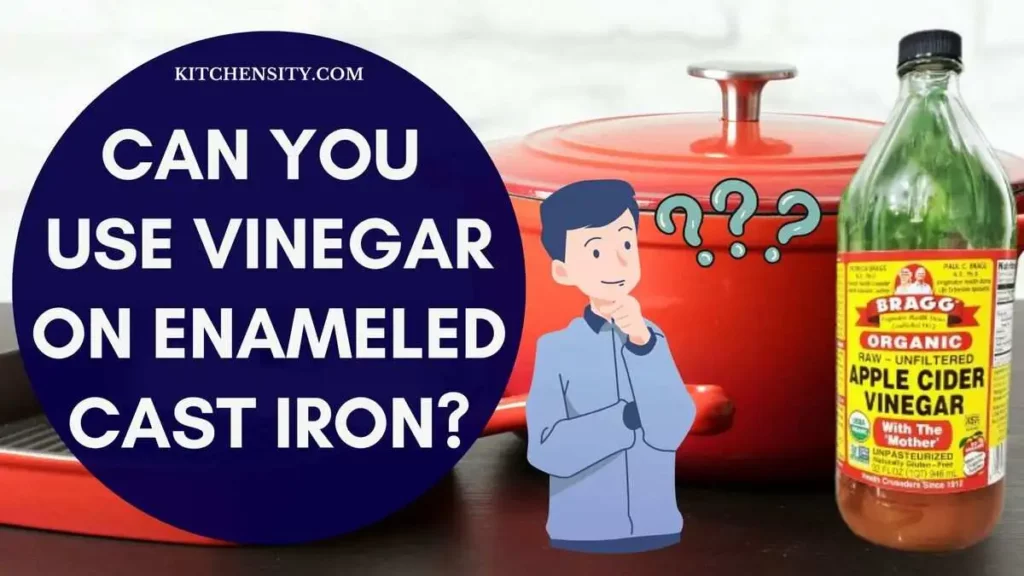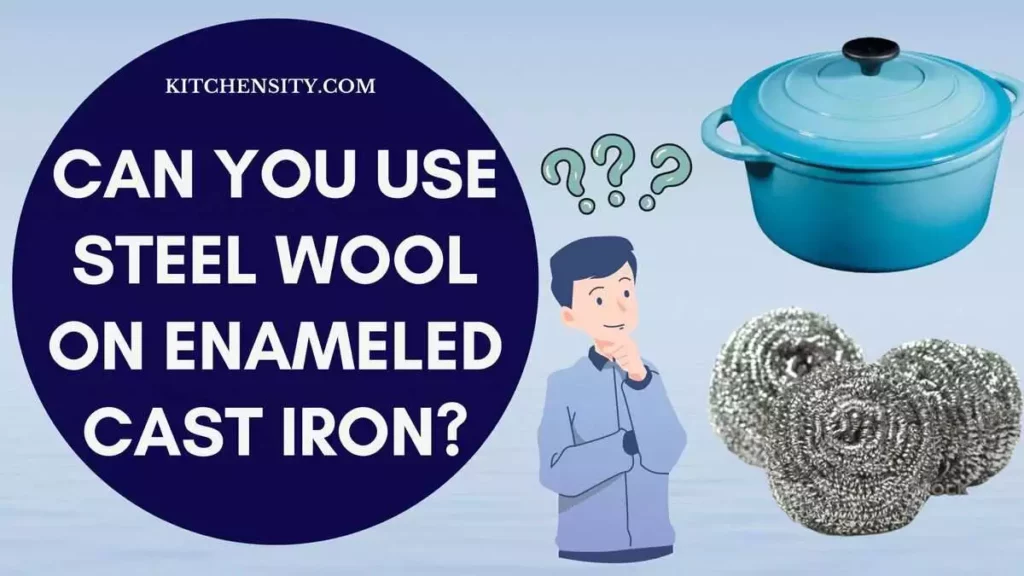Something is enchanting about cooking with cast iron—the sizzle of food hitting the seasoned surface, the aroma of flavors mingling, and the promise of perfectly cooked meals.
However, over time, even the most cherished cast iron griddles can lose their luster, accumulating rust and losing their once-prized non-stick properties.
But fear not! The art of restoring a cast iron griddle is a time-honored practice that can revive this classic cookware to its former glory.
In this comprehensive guide, we will take you on a journey through the step-by-step process of restoring a cast iron griddle.
From inspecting and removing rust and old seasoning to applying a perfect seasoning layer, we’ll explore the tips and techniques that ensure a successful restoration.
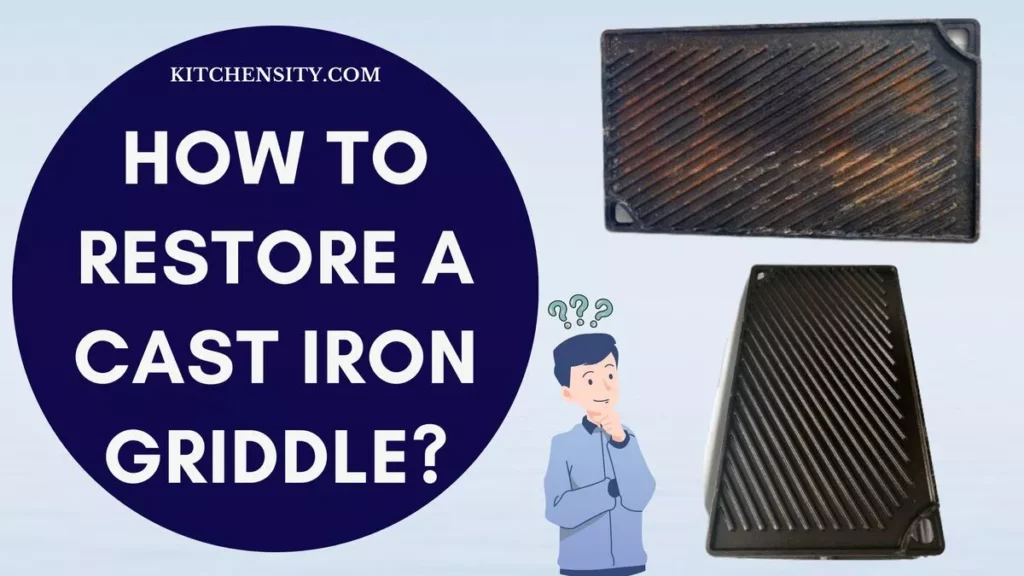
Table of Contents
- 1 How To Restore A Cast Iron Griddle?
- 2 Understanding Cast Iron Griddles
- 3 Why Restore A Cast Iron Griddle?
- 4 Safety Precautions
- 5 Cleaning The Griddle
- 6 Restoring The Surface Of The Cast Iron Griddle
- 7 Seasoning The Griddle
- 8 Maintaining Your Restored Griddle
- 9 How Do You Restore An Old Cast Iron Griddle?
- 10 How Do You Clean Crud Off A Cast Iron Griddle?
- 11 Final Verdict
- 12 Frequently Asked Questions (FAQs)
- 12.1 How Do You Reseason A Cast Iron Griddle?
- 12.2 Can I Use Soap To Clean A Restored Cast Iron Griddle?
- 12.3 How Often Should I Season My Cast Iron Griddle?
- 12.4 Can I Use Metal Utensils On A Restored Cast Iron Griddle?
- 12.5 Can I Store Food On A Cast Iron Griddle After Cooking?
- 12.6 Can I Use My Cast Iron Griddle On An Induction Cooktop?
How To Restore A Cast Iron Griddle?
To restore a cast iron griddle, gently remove rust and old seasoning with vinegar and scrubbing. Apply a thin layer of oil or lard to the surface, then bake in the oven to create a durable, non-stick coating. Enjoy the renewed joy of cooking on a well-restored griddle!
Read below for a detailed guide.
Also Read – How To Clean A Cast Iron BBQ Griddle?
Understanding Cast Iron Griddles
Cast iron griddles are thick, heavy-duty cooking surfaces known for their durability. They are commonly used for cooking a variety of foods, including pancakes, eggs, and sandwiches. The key to their effectiveness lies in proper seasoning, which creates a non-stick surface.
Why Restore A Cast Iron Griddle?
Restoring a cast iron griddle is essential for several reasons:
- Improved Cooking Performance: A well-seasoned cast iron griddle provides a natural non-stick surface, making it easier to cook various foods without them sticking to the surface. This results in better cooking performance and more enjoyable meals.
- Preventing Rust: Over time, cast iron griddles can develop rust if not properly maintained. Restoring the griddle removes rust and prevents further corrosion, ensuring its longevity.
- Enhanced Flavor: Seasoning the griddle creates a protective layer that enhances the flavor of the food cooked on it. It adds a rich, smoky taste to dishes, making them more delicious.
- Versatility: A restored cast iron griddle is highly versatile and can be used for cooking a wide range of foods, from pancakes and eggs to steaks and sandwiches. It’s a valuable addition to any kitchen.
- Cost-Effective: Restoring a cast iron griddle is more cost-effective than buying a new one. With proper care, a restored griddle can last for generations, making it a long-term investment.
- Eco-Friendly: Choosing to restore a cast iron griddle instead of replacing it contributes to sustainability by reducing waste.
- Preserving Tradition: Cast iron griddles have been used for generations, and restoring them helps preserve this traditional cooking method and the history associated with it.
- Heat Retention: Cast iron’s exceptional heat retention ensures even cooking and heat distribution, resulting in evenly cooked meals.
- Health Benefits: A well-maintained cast iron griddle requires less oil for cooking, making it a healthier option for those looking to reduce their oil intake.
- Cooking Safety: A properly seasoned griddle reduces the risk of food sticking and burning, leading to safer and more enjoyable cooking experiences.
So, restoring a cast iron griddle not only improves its cooking performance but also extends its lifespan while offering various benefits, including enhanced flavor, versatility, and cost-effectiveness.
With proper maintenance, a restored cast iron griddle can become a beloved and reliable cooking companion in the kitchen.
Also Read – Why Is Cast Iron Pan Sticky After Seasoning?
Safety Precautions
When restoring a cast iron griddle, it is crucial to prioritize safety to ensure a smooth and risk-free process. Here are some essential safety precautions to keep in mind:
- Ventilation: Work in a well-ventilated area, preferably outdoors or near an open window. The restoration process may produce smoke or fumes, so proper ventilation helps avoid inhaling potentially harmful substances.
- Protective Gear: Wear appropriate protective gear, including heat-resistant gloves and eye protection. This safeguards your hands and eyes from potential splatters, hot surfaces, and chemical exposure.
- Avoid Water: Never immerse a hot or warm cast iron griddle in water. Rapid temperature changes can cause the iron to crack or warp, rendering the griddle unusable. Allow the griddle to cool naturally before cleaning or handling.
- Use Proper Cleaning Tools: When scrubbing the griddle to remove rust and old seasoning, opt for non-abrasive materials such as soft brushes, scrub pads, or steel wool. Avoid harsh scouring pads or wire brushes that might damage the surface.
- Mind The Chemicals: If you need to use cleaning solutions, make sure they are safe for cast iron. Avoid harsh chemicals that can corrode the metal or leave harmful residues.
- Heat Source Precautions: When heating the griddle in the oven during the restoration process, be cautious while handling hot surfaces. Use oven mitts or heat-resistant gloves to avoid burns.
- Keep Children And Pets Away: During the restoration process, keep children and pets at a safe distance from the work area to prevent accidents or injuries.
- Proper Disposal: Dispose of any used cleaning materials and chemicals safely and according to local regulations.
- Avoid Overheating: When baking the griddle with oil or lard, ensure you do not exceed the recommended temperature. Overheating might damage the seasoning or lead to unwanted fumes.
- Work With Caution: Take your time and work with care during the entire restoration process. Rushing or being careless can lead to accidents and compromised results.
Also Read – Seasoned Vs Unseasoned Cast Iron Skillet
Cleaning The Griddle
1. Removing Rust
Removing rust from a cast iron griddle is a critical step in the restoration process to ensure a clean and smooth cooking surface. Here’s how to effectively remove rust from your griddle:
- Prepare The Griddle: Place the cast iron griddle on a flat, stable surface, and ensure it is completely cool before starting the rust removal process.
- Scrubbing With Steel Wool: Using a steel wool pad or a stiff brush, gently scrub the rusted areas on the griddle. Apply moderate pressure to remove the rust without damaging the underlying cast iron surface.
- White Vinegar Solution: For tougher rust spots, create a mixture of equal parts white vinegar and water. Apply this solution to the rusted areas using a cloth or sponge. Let it sit for a few minutes to loosen the rust.
- Scrubbing Again: After allowing the vinegar solution to work, scrub the rusted spots again with the steel wool or brush. This will help lift off the loosened rust and reveal the original cast iron surface.
- Rinse Thoroughly: Once you have removed the rust, rinse the griddle thoroughly with warm water to remove any remaining vinegar or rust particles.
- Dry Completely: Use a clean cloth or paper towel to dry the griddle completely. Ensure there is no moisture left on the surface, as cast iron is susceptible to rusting when exposed to water.
- Inspect For Remaining Rust: After drying, inspect the griddle to check if any rust spots are still present. If you notice any, repeat the scrubbing process until the griddle is rust-free.
- Apply Oil Or Lard: To protect the griddle from future rusting, apply a thin layer of cooking oil or melted lard to the entire surface. This acts as a protective barrier against moisture.
Remember, patience and gentle handling are essential when removing rust from a cast iron griddle. Avoid using harsh chemicals or abrasive materials that can damage the griddle’s surface.
With proper care, you can effectively eliminate rust and restore your cast iron griddle to its former glory, ready to serve you delicious meals for years to come.
Also Read – Why Do Cast Iron Pans Crack?
2. Removing Old Seasoning
Removing old seasoning from a cast iron griddle is a crucial step in the restoration process to create a clean and smooth surface for re-seasoning. Here’s how to effectively remove old seasoning from your griddle:
- Prepare The Griddle: Ensure the cast iron griddle is completely cool before starting the process of removing old seasoning.
- Scrubbing With Hot Water: Begin by scrubbing the griddle’s surface with hot water and a non-abrasive brush or sponge. This will help to loosen any loose or flaking seasoning.
- Vinegar Solution: Create a mixture of equal parts white vinegar and water. Apply the vinegar solution to the griddle’s surface using a cloth or sponge. Let it sit for a few minutes to help break down the old seasoning.
- Scrubbing Again: After allowing the vinegar solution to work, scrub the griddle’s surface again with the brush or sponge. This will help lift off the loosened seasoning.
- Rinse Thoroughly: Once you have removed the old seasoning, rinse the griddle thoroughly with warm water to remove any remaining vinegar or seasoning particles.
- Dry Completely: Use a clean cloth or paper towel to dry the griddle completely. Ensure there is no moisture left on the surface to prevent rusting.
- Inspect For Remaining Seasoning: After drying, inspect the griddle’s surface to check if any old seasoning is still present. If necessary, repeat the scrubbing process until the griddle is free from old seasoning.
By following these steps, you can effectively remove old seasoning from your cast iron griddle, preparing it for the next stage of the restoration process.
After successfully removing the old seasoning, the griddle will be ready for cleaning and restoring its seasoned surface to ensure optimal cooking performance and a non-stick cooking surface.
Also Read – How To Clean A Cast Iron Grill Pan?
3. Scrubbing And Soaking
Scrubbing and soaking are essential steps in the restoration process for a cast iron griddle, helping to clean the surface thoroughly and remove any stubborn residue. Here’s how to effectively scrub and soak your griddle:
- Scrubbing The Griddle: Using a soft-bristled brush, non-abrasive scrub pad, or steel wool, gently scrub the entire surface of the griddle. This helps to remove any remaining rust, old seasoning, or stubborn food residues.
- Baking Soda Paste: For tougher stains or residues, create a paste by mixing baking soda with water. Apply the paste to the affected areas on the griddle’s surface. Let it sit for a few minutes to allow the baking soda to work its magic.
- Scrubbing Again: After letting the baking soda paste sit, scrub the griddle once more with the brush or scrub pad. The baking soda acts as a natural abrasive, helping to lift off stubborn residues without damaging the cast iron surface.
- Soaking The Griddle:
- If there are particularly stubborn or hard-to-reach spots, consider soaking the griddle.
- Fill a sink or large container with warm water and a small amount of dish soap.
- Submerge the griddle and let it soak for some time to help loosen any remaining residues.
- Gentle Scrubbing During Soaking: While the griddle is soaking, you can gently scrub it again using a sponge or soft cloth. This allows you to remove any loosened residues more effectively.
- Rinse Thoroughly: Once you’re satisfied with the scrubbing and soaking process, rinse the griddle thoroughly with warm water to remove any cleaning agents or residues.
- Dry Completely: Use a clean cloth or paper towel to dry the griddle completely. Ensure there is no moisture left on the surface to prevent rusting.
By following these steps, you can effectively scrub and soak your cast iron griddle, preparing it for the next stages of the restoration process.
With a clean and residue-free surface, your griddle will be ready for the oiling and seasoning process, ensuring excellent cooking performance and a well-seasoned, non-stick surface for your culinary endeavors.
Also Read – Cast Iron Skillet Gift Basket Ideas
Restoring The Surface Of The Cast Iron Griddle
1. Applying Oil Or Lard
Applying oil or lard is a crucial step in the restoration process for a cast iron griddle, as it helps to create a protective barrier and build up a new seasoning layer. Here’s how to effectively apply oil or lard to your griddle:
- Choose The Right Oil Or Lard: Select a high-smoke-point oil for seasoning your cast iron griddle. Some suitable options include vegetable oil, canola oil, grapeseed oil, or flaxseed oil. Alternatively, you can use melted lard for this process.
- Clean And Dry The Griddle: Before applying the oil or lard, ensure that the griddle is thoroughly cleaned and completely dry. Any water or moisture on the surface can hinder the seasoning process.
- Apply A Thin Layer: Using a paper towel or clean cloth, apply a thin layer of the chosen oil or melted lard to the entire surface of the griddle. Make sure to cover every nook and cranny, including the handle and sides.
- Avoid Excess Oil: Be mindful not to apply too much oil or lard, as a thick layer can lead to uneven seasoning or a sticky surface.
- Preheat The Griddle: Place the griddle upside down in an oven preheated to 350°F (175°C). To catch any drips, you can place a baking sheet or aluminum foil on the lower oven rack.
- Baking Process: Bake the griddle in the preheated oven for about an hour. This allows the oil or lard to bond with the cast iron, forming a protective layer.
- Cool Down: After the baking process, turn off the oven and let the griddle cool down naturally. Do not remove the griddle from the oven while it is still hot.
- Repeat The Process: To build up a solid seasoning layer, you can repeat the oiling and baking process two or three more times. This helps to enhance the griddle’s non-stick properties and improve its overall performance.
By following these steps, you can effectively apply oil or lard to your cast iron griddle, ensuring a well-seasoned and non-stick cooking surface.
Proper seasoning is the key to a successful restoration, and with each use, your griddle will only improve in performance and become a cherished tool in your kitchen.
Also Read – Can You Use Olive Oil To Season Cast Iron Pans?
2. Heating The Griddle
Heating the cast iron griddle is a critical step in the restoration process as it helps to bond the oil or lard with the surface, creating a durable and non-stick seasoning layer. Here’s how to effectively heat the griddle:
- Preheat The Oven: Before heating the griddle, preheat your oven to 350°F (175°C). This temperature is ideal for the seasoning process.
- Apply Oil Or Lard: Make sure you have already applied a thin layer of the chosen oil or melted lard to the entire surface of the griddle as part of the previous step.
- Place The Griddle Upside Down: Once the oven is preheated, place the cast iron griddle upside down on the oven rack. This positioning allows any excess oil or lard to drip off during the heating process.
- Use A Baking Sheet Or Foil: To catch any drips and prevent them from falling onto the oven’s bottom, place a baking sheet or aluminum foil on the lower oven rack under the griddle.
- Bake For An Hour: Allow the griddle to bake in the preheated oven for approximately one hour. This duration ensures that the oil or lard bonds well with the cast iron surface, creating a protective layer.
- Turn Off The Oven: After the baking process is complete, turn off the oven. Do not remove the griddle from the oven immediately. Let it cool down gradually to avoid temperature shocks.
- Repeat The Process: To further enhance the seasoning and develop a more robust non-stick surface, you can repeat the oiling and heating process two or three more times. This step helps to build up a resilient seasoning layer.
Remember, heating the griddle is a vital part of the restoration process. By following these steps and being patient during each round of seasoning, you can achieve a beautifully seasoned cast iron griddle that is ready to deliver excellent cooking performance and delectable dishes.
Also Read – Is It Safe To Cook In A Rusty Cast Iron Pan?
3. Repeating The Process
Repeating the process of applying oil or lard and heating the cast iron griddle is an important step in the restoration process to ensure a well-seasoned and non-stick cooking surface. Here’s how to effectively repeat the process:
- Cool Down: After the initial heating process, allow the griddle to cool down completely in the oven. This ensures a safe handling temperature before proceeding.
- Apply Oil Or Lard: Once the griddle has cooled down, inspect the seasoning layer. If it appears uneven or if you notice any bare spots, apply another thin layer of oil or melted lard to the entire surface.
- Preheat The Oven: Preheat your oven to 350°F (175°C) again to prepare for the second round of seasoning.
- Place The Griddle Upside Down: Position the griddle upside down on the oven rack to allow any excess oil or lard to drip off during the heating process.
- Use A Baking Sheet Or Foil: To catch any drips and prevent them from falling onto the oven’s bottom, place a baking sheet or aluminum foil on the lower oven rack under the griddle.
- Bake For An Hour: Once the oven is preheated, place the griddle inside and let it bake for approximately one hour. This will help bond the additional layer of oil or lard with the cast iron surface.
- Cool Down Again: After the second round of seasoning, turn off the oven and let the griddle cool down gradually. Avoid removing the griddle from the oven while it is still hot.
- Repeat As Needed: Depending on the condition of the griddle and the desired seasoning level, you can repeat the oiling and heating process two or three more times. Each round of seasoning builds up a stronger non-stick surface.
- Check For Uniformity: After each round of seasoning, check the griddle’s surface for uniformity. The seasoning layer should appear smooth and even, providing an excellent non-stick cooking surface.
Also Read – Why Griswold Cast Iron Is So Expensive?
Seasoning The Griddle
Seasoning the cast iron griddle is a crucial step in the restoration process, as it creates a protective and non-stick coating on the surface. Here’s how to effectively season your griddle:
- Choose The Right Oil: Opt for an oil with a high smoke point, such as flaxseed oil, grapeseed oil, vegetable shortening, or canola oil. These oils are best for achieving a durable seasoning.
- Clean And Dry The Griddle: Ensure that the griddle is thoroughly cleaned and completely dry before starting the seasoning process. Any moisture or residue can interfere with the seasoning.
- Apply A Thin Layer Of Oil: Using a paper towel or cloth, apply a thin layer of the chosen oil to the entire surface of the griddle, including the handle and sides. Make sure to coat the surface evenly.
- Preheat The Oven: Preheat your oven to 450°F (230°C). This higher temperature helps to polymerize the oil, creating a durable and non-stick layer.
- Place The Griddle Upside Down: Position the griddle upside down on the oven rack. Placing it upside down ensures that any excess oil drips away during the seasoning process.
- Use A Baking Sheet Or Foil: To catch any drips and prevent them from falling onto the oven’s bottom, place a baking sheet or aluminum foil on the lower oven rack under the griddle.
- Bake For 30 Minutes: Once the oven is preheated, put the griddle inside and bake it for approximately 30 minutes. This allows the oil to penetrate the cast iron and create a strong bond.
- Cool Down Gradually: After the baking process, turn off the oven and let the griddle cool down gradually. Avoid removing the griddle from the oven while it is still hot.
- Repeat The Process: To achieve a well-developed seasoning layer, repeat the oiling and baking process several times. Applying multiple coats of oil and baking in between helps build a robust and non-stick surface.
- Final Baking: After the last round of seasoning, allow the griddle to cool down in the oven. The final baking ensures that the seasoning layer is properly set and ready for use.
By following these steps, you can effectively season your cast iron griddle, creating a protective and non-stick coating that will enhance its cooking performance and durability.
A well-seasoned griddle is a valuable tool in your kitchen, providing you with the perfect surface for cooking a variety of delicious meals.
Also Read – Is Enameled Cast Iron Cookware Safe?
Maintaining Your Restored Griddle
Maintaining your restored cast iron griddle is essential to keep it in excellent condition and ensure its longevity. With proper care, your griddle will continue to deliver exceptional cooking performance and a non-stick surface.
Here are some tips for maintaining your restored griddle:
- Avoid Soap: After each use, avoid using soap for regular cleaning. Soap can strip away the seasoning, diminishing the non-stick properties of the griddle. Instead, opt for hot water and a gentle scrubbing pad or brush to remove food residues.
- Gentle Cleaning: When cleaning the griddle, be gentle to avoid scratching or damaging the seasoned surface. A gentle scrubbing with a soft-bristled brush or non-abrasive scrub pad is usually sufficient to clean it effectively.
- Seasoning Touch-Ups: Over time, the seasoning on the griddle may wear off in certain spots. To maintain the non-stick surface, apply a thin layer of oil or lard to those areas and bake the griddle again following the seasoning process.
- Dry Thoroughly: After cleaning, make sure to dry the griddle thoroughly to prevent rusting. You can place it on low heat on the stovetop for a few minutes or dry it with a towel before storing it.
- Apply A Light Layer Of Oil: Before storing your griddle, apply a light layer of cooking oil to the entire surface. This helps to protect the seasoning and prevents moisture from coming into contact with the cast iron.
- Store Properly: Store the griddle in a dry place with good air circulation. Avoid stacking other cookware on top of it, as this can cause pressure points and potentially damage the seasoned surface.
- Avoid Acidic Foods: Acidic foods can break down the seasoning and cause unwanted flavors. Avoid cooking highly acidic foods for extended periods on the griddle.
- Re-Seasoning As Needed: Depending on usage, you may need to re-season your griddle periodically. If you notice a decline in its non-stick properties, perform the seasoning process again to restore its surface.
By following these maintenance tips, you can keep your restored cast iron griddle in top condition, ensuring optimal cooking performance and a non-stick surface for your favorite dishes.
Proper care and attention will make your cast iron griddle a reliable and cherished tool in your kitchen for many years to come.
Also Read – Do You Need To Season Enameled Cast Iron?
How Do You Restore An Old Cast Iron Griddle?
Restoring an old cast iron griddle is a rewarding process that can bring new life to your cookware and improve its cooking performance. Here’s a step-by-step guide on how to restore an old cast iron griddle:
- Inspect The Griddle: Before starting the restoration process, thoroughly inspect the griddle for rust, old seasoning, and any damage. Note the areas that need attention.
- Safety Precautions: Wear protective gloves and eye gear to ensure your safety during the restoration process.
- Remove Rust: If there is rust on the griddle, scrub it gently with steel wool or a non-abrasive brush to remove the rust. Rinse and dry the griddle completely.
- Remove Old Seasoning: To remove old seasoning, create a mixture of equal parts white vinegar and water. Apply the solution to the griddle and scrub away the old seasoning with a soft brush. Rinse and dry thoroughly.
- Scrub And Soak: For stubborn residues, make a paste using baking soda and water. Apply it to the griddle, let it sit for a few minutes, and then scrub away the residue. Alternatively, you can soak the griddle in warm water with a small amount of dish soap to loosen residues.
- Dry Thoroughly: After cleaning, ensure the griddle is completely dry to prevent rust.
- Apply Oil Or Lard: Coat the entire surface of the griddle with a thin layer of cooking oil or melted lard. Make sure to cover every nook and cranny.
- Preheat The Oven: Preheat your oven to 350°F (175°C).
- Place The Griddle Upside Down: Place the griddle upside down on the oven rack to catch any excess oil or lard during the heating process.
- Bake The Griddle: Bake the griddle in the preheated oven for about an hour. This allows the oil or lard to bond with the cast iron surface and create a protective layer.
- Cool Down Gradually: After baking, turn off the oven and let the griddle cool down gradually. Avoid removing it from the oven while it’s still hot.
- Repeat The Seasoning Process: For a more robust seasoning, you can repeat the oiling and baking process two or three more times. Each round of seasoning adds to the griddle’s non-stick properties.
- Inspect And Maintain: After seasoning, inspect the griddle’s surface for uniformity and proper seasoning. Regularly maintain the griddle by avoiding soap during cleaning, drying it thoroughly, and applying a light layer of oil before storing.
By following these steps, you can successfully restore an old cast iron griddle, transforming it into a valuable and reliable piece of cookware for many more years of enjoyable cooking.
Also Read – Can You Use Enameled Cast Iron On A Glass Cooktop?
How Do You Clean Crud Off A Cast Iron Griddle?
Cleaning crud off a cast iron griddle requires a gentle approach to avoid damaging the seasoned surface. Here’s how to effectively clean the crud off your cast iron griddle:
- Cool Down: Allow the cast iron griddle to cool down completely before cleaning. Cleaning a hot griddle can be hazardous and may cause burns.
- Remove Excess Food: Use a spatula or scraper to remove any excess food or large debris from the griddle’s surface. Gently scrape without applying too much pressure to avoid scratching the cast iron.
- Warm Water And Scrubbing: Pour warm water onto the griddle and use a soft-bristled brush or non-abrasive scrub pad to scrub the surface. This helps to loosen the crud without damaging the seasoned layer.
- Baking Soda Paste: For stubborn or sticky crud, create a paste by mixing baking soda with water. Apply the paste to the affected areas and let it sit for a few minutes to help break down the crud.
- Scrub Again: After the baking soda paste has had some time to work, scrub the griddle again with the brush or scrub pad. Gently scrub in circular motions to remove the remaining crud.
- Rinse Thoroughly: Rinse the griddle thoroughly with warm water to remove any cleaning agents or residue.
- Dry Completely: Use a clean cloth or paper towel to dry the griddle completely. Ensure there is no moisture left on the surface to prevent rusting.
- Oil The Griddle: To protect the cast iron and maintain its seasoned surface, apply a thin layer of cooking oil to the entire surface of the griddle. Use a paper towel to spread the oil evenly.
- Heat The Griddle: Place the griddle on the stovetop over medium heat for a few minutes to help the oil bond with the cast iron surface. This step aids in preserving the non-stick properties.
By following these steps, you can effectively clean the crud off your cast iron griddle without compromising its seasoned surface.
Regular and gentle cleaning will keep your griddle in excellent condition and ensure it continues to provide you with delicious and evenly cooked meals for years to come.
Also Read – Can You Put Enamel Cast Iron In The Dishwasher?
Final Verdict
Restoring a cast iron griddle is a rewarding and worthwhile endeavor that breathes new life into this timeless cookware.
Through a careful process of removing rust and old seasoning, scrubbing, applying oil or lard, and heating, the griddle transforms into a durable, non-stick cooking surface that can withstand the test of time.
The restoration process not only enhances the griddle’s cooking performance but also preserves its traditional and historical significance.
A well-seasoned cast iron griddle becomes a cherished kitchen companion, capable of preparing a wide array of delicious dishes with ease.
Maintaining the restored griddle is essential to ensure its continued excellence. With gentle cleaning methods, proper drying, and occasional re-seasoning, this valuable piece of cookware can serve generations to come.
By taking the time and care to restore a cast iron griddle, one can rediscover the joys of cooking on this versatile and dependable kitchen tool.
From sizzling breakfasts to succulent dinners, a well-restored cast iron griddle becomes an integral part of creating memorable and delectable meals.
So, if you have an old cast iron griddle waiting for a revival, do not hesitate to embark on the restoration journey.
With patience and attention, you can bring back its former glory and savor the delights of cooking on a well-seasoned and lovingly maintained cast iron griddle. Happy cooking!
Also Read – How To Season And Clean Cast Iron Cookware?
Frequently Asked Questions (FAQs)
-
How Do You Reseason A Cast Iron Griddle?
To reseason a cast iron griddle, apply a thin layer of cooking oil or melted lard to the surface, then bake in the oven at 350°F (175°C) for an hour. Repeat the process if needed for a robust, non-stick coating.
-
Can I Use Soap To Clean A Restored Cast Iron Griddle?
No, using soap for regular cleaning can remove the seasoning. Stick to hot water and gentle scrubbing.
-
How Often Should I Season My Cast Iron Griddle?
It’s a good idea to season your griddle once every few months, depending on usage.
-
Can I Use Metal Utensils On A Restored Cast Iron Griddle?
Yes, but be gentle to avoid scratching the surface.
-
Can I Store Food On A Cast Iron Griddle After Cooking?
It’s best to transfer food to a separate dish or plate after cooking to prevent acidic food from affecting the seasoning.
-
Can I Use My Cast Iron Griddle On An Induction Cooktop?
No, cast iron griddles are not suitable for induction cooktops.
Katrina Smith is a seasoned expert with over 25 years of experience in all things related to cooking and the kitchen. As an avid cook and kitchen enthusiast, she is passionate about sharing her knowledge and expertise on cookware, kitchen appliances, kitchen tips, and kitchen staples.
Through her articles and reviews, Katrina aims to inspire and help others improve their cooking skills, experiment with different ingredients, and invest in quality cookware and appliances.

![How To Season And Clean Cast Iron Cookware? [4 Effective Ways] 3 How To Season And Clean Cast Iron Cookware](https://www.kitchensity.com/wp-content/uploads/2020/06/How-To-Season-And-Clean-Cast-Iron-Cookware.jpg)
